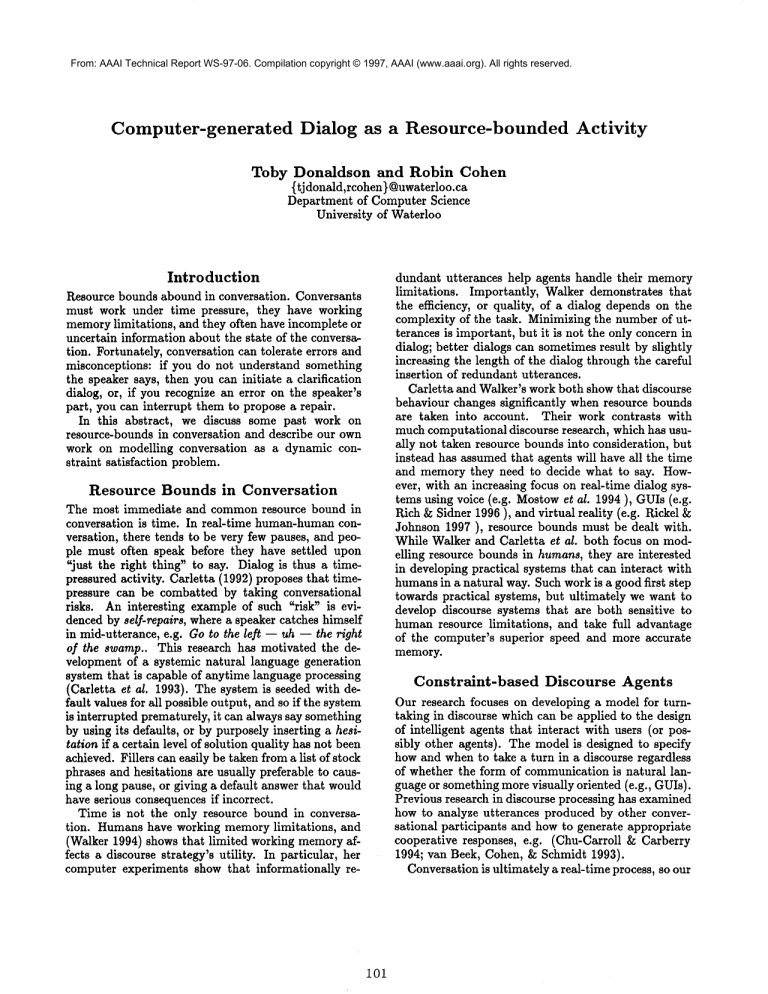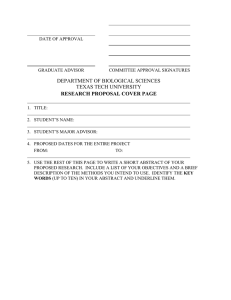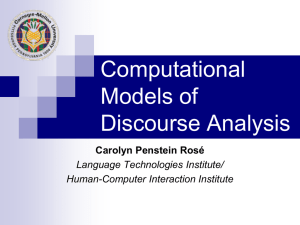
From: AAAI Technical Report WS-97-06. Compilation copyright © 1997, AAAI (www.aaai.org). All rights reserved.
Computer-generated
Toby
Dialog
as a Resource-bounded
Activity
Donaldson
and Robin
Cohen
{tjdonald,rcohen}@uwaterloo.ca
Department of Computer Science
University of Waterloo
dundant utterances help agents handle their memory
limitations.
Importantly, Walker demonstrates that
the efficiency, or quality, of a dialog depends on the
complexity of the task. Minimizing the number of utterances is important, but it is not the only concern in
dialog; better dialogs can sometimes result by slightly
increasing the length of the dialog through the careful
insertion of redundant utterances.
Carletta and Walker’s work both show that discourse
behaviour changes significantly when resource bounds
are taken into account. Their work contrasts with
muchcomputational discourse research, which has usually not taken resource bounds into consideration, but
instead has assumed that agents will have all the time
and memory they need to decide what to say. However, with an increasing focus on real-time dialog systems using voice (e.g. Mostowet al. 1994 ), GUIs (e.g.
Rich & Sidner 1996 ), and virtual reality (e.g. Rickel
Johnson 1997 ), resource bounds must be dealt with.
While Walker and Carletta et al. both focus on modelling resource bounds in humans, they are interested
in developing practical systems that can interact with
humansin a natural way. Such work is a good first step
towards practical systems, but ultimately we want to
develop discourse systems that are both sensitive to
human resource limitations,
and take full advantage
of the computer’s superior speed and more accurate
memory.
Introduction
Resource bounds abound in conversation. Conversants
must work under time pressure, they have working
memorylimitations, and they often have incomplete or
uncertain information about the state of the conversation. Fortunately, conversation can tolerate errors and
misconceptions: if you do not understand something
the speaker says, then you can initiate a clarification
dialog, or, if you recognize an error on the speaker’s
part, you can interrupt them to propose a repair.
In this abstract,
we discuss some past work on
resource-bounds in conversation and describe our own
work on modelling conversation as a dynamic constraint satisfaction problem.
Resource
Bounds in Conversation
The most immediate and commonresource bound in
conversation is time. In real-time human-humanconversation, there tends to be very few pauses, and people must often speak before they have settled upon
~just the right thing" to say. Dialog is thus a timepressured activity. Carletta (1992) proposes that timepressure can be combatted by taking conversational
risks. An interesting example of such "risk" is evidenced by self-repairs, where a speaker catches himself
in mid-utterance, e.g. Go to the left -- uh -- the right
of the swamp.. This research has motivated the development of a systemic natural language generation
system that is capable of anytime language processing
(Carletta et al. 1993). The system is seeded with default values for all possible output, and so if the system
is interrupted prematurely, it can always say something
by using its defaults, or by purposely inserting a hesitation if a certain level of solution quality has not been
achieved. Fillers can easily be taken from a list of stock
phrases and hesitations are usually preferable to causing a long pause, or giving a default answer that would
have serious consequencesif incorrect.
Time is not the only resource bound in conversation. Humans have working memory limitations,
and
(Walker 1994) shows that limited working memoryaffects a discourse strategy’s utility. In particular, her
computer experiments show that informationally re-
Constraint-based
Discourse
Agents
Our research focuses on developing a model for turntaking in discourse which can be applied to the design
of intelligent agents that interact with users (or possibly other agents). The model is designed to specify
howand when to take a turn in a discourse regardless
of whether the form of communication is natural language or something more visually oriented (e.g., GUIs).
Previous research in discourse processing has examined
how to analyze utterances produced by other conversational participants and how to generate appropriate
cooperative responses, e.g. (Chu-Carroll & Carberry
1994; van Beek, Cohen, & Schmidt 1993).
Conversation is ultimately a real-time process, so our
i01
model explicitly takes time constraints into account.
Wetreat a conversational agent as consisting of three
separate and concurrent processes:
* A pre-proeessing module that takes raw speech (or
key clicks, or mouse movements, etc.) as input and
converts that into a form the agent can reason with;
. A thinking module that solves a turn-taking problem;
the solution to a turn-taking problem is effectively
the system’s next utterance;
. A listening module that looks for the appropriate
turn-endlng and turn-yielding signals from the current speaker. An agent needs to knowif its current
solution is of high enough quality to be used, but
it needs to knowif the current speaker is willing to
give up the floor.
This model does not require any one particular kind
of implementation strategy, although we are interested
in modelling complex interaction as a kind of dynamic
constraint satisfaction
problem (DCSP) that can
solved by local search methods. At any time in a conversation, an agent will have some number of goals
to consider, and one (or more) must be chosen to
achieved. More concretely, at any one time, an agent
is considering which goal to act upon from a list of
goals Gi,..., G~. The problem is for the agent to find
the n (usually < k) goals that can be placed in the
order that results in the fewest penalty points. A fixed
numberof slots, labelled V1,..., V, are used, and it is
knownthat when the agent is required to act, it will
first try to achieve the goal in slot V1, and then V2,
and so on. Ordering constraints can be put on pairs
of goals, such that if two constrained goals are out of
order, a penalty is incurred. A perfect ordering would
have 0 penalty points. Wemodel this problem as a
DCSP, which is a natural and flexible framework for
representing such an ordering problem. It is dynamic
since, new goals/constraints
may be added/dropped,
based on what the other conversant says and how the
conversation progresses.
It is important to note that we are assuming a local
search method will be used to solve the DCSP.Classical backtracking methods could be used (Tsang 1993),
hut local search is preferable for at least three reasons:
local search algorithms are usually anytime algorithms;
local search methods work on over-constrained CSPs
without modification; and, when the structure of the
DCSPchanges, i.e. a constraint or goal is changed,
then the best solution found for the previous CSPcan
be used to seed the current caP.
As mentioned, the constraints are between pairs of
goals, and they generally refer to the types of goals.
For example, repair type goals should usually be satisfied before information-seeking goals, because the repair could affect the correctness of the information being sought. Other constraints based on time, causality, user preferences, the domain, etc. can also be
taken into consideration. More details on the par-
102
ticular DCSPwe are solving and the relevant constraints can be found in (Donaldson & Cohen 1997a;
1997b).
Example
Dialog
What follows is a simplified example of how the DCSP
framework works. Suppose a student goes to a course
advisor for help choosing a schedule of courses. The
student begins by asking
STUDENT:
I’m a part-time engineering major.
Can I take CSIO0for credit?
As the student is speaking, the advisor is listening and
we assume that question type goals are triggered in
the advisor. Question-type goals are less specific than
the goal-types given in (Donaldson & Cohen 1997b),
but they are adequate to handle the current example.
Wesuppose that 4 yes/no question goals are triggered
roughly in the order given:
¯ GI: "Are you in electrical engineering?" (electrical
engineering students cannot take CS100)
¯ G2: "Are you minoring in mathematics?" (math
minor students cannot take CSl00)
¯ G3: "Do you mean CSl00 on-campus?" (CS100 is
an ambiguous name)
¯ G4: "Have you taken a CS course for credit?" (you
cannot take CSIO0 if you’ve taken any other CS
course)
The problem is to put G1,...,G4 in the order that
minimizes the length of the dialog. For this example,
the only concern is to answer the question posed by the
user; moreover, the answer to G3 does not alter the ultimate advice to the student. Goals G1 and G2are triggered because the system believes by default that an
engineering or math student must have already taken
a CS course. Question G4 "covers" Gi and G2, and
we can see that it is the best question to ask first. The
idea of minimizing the number of questions asked was
first used by van Beek et al. (1993) to direct the design
of clarification subdialogs wheninferring a user’s plan.
The DCSPformalism we represent here is more general, since it deals with arbitrary constraints between
general turn-taking goals, and allows for anytime processing. Without being able to fully reason about the
set of possible goals, the system could, for instance,
produce the dialog below (based on the goal ordering
G1, G2, G3, G4):
ADVISOR:
Are you in electrical engineering?
STUDENT:
No.
ADVISOR:Are you minoring in mathematics?
STUDENT:
NO.
ADVISOR:Do you mean CSIO0 on-campus?
STUDENT:Yes.
ADVISOR:Have you taken a CS course for credit?
STUDENT:Yes.
ADVISOI~:Since you’ve already taken a CS course,
you cannot take CSIO0for credit.
For example, the student might speak so quickly that
the advisor has no chance to perform any goal-ordering
while the student is speaking. Advising sessions are
not typically highly time-pressured situations, but examples do arise where a student will deliver a lot of
information quite quickly; in this situation, the advisor might hesitate in order to buy some more thinking
time. Wecould follow the suggestion of Carletta et al.
and decide whento hesitate instead of trying to achieve
the first goal, by checking if the goal-ordering is above
a domain-dependantquality threshold Ohe.ltate.1 Then,
if the system is forced to act 2 and the solution quality
is belowOhe.itate, it can hesitate by saying, for instance,
Let me think about that..., in the hope that in the time
it takes to say this an acceptable goal ordering will be
found. If the system has not found a better goal ordering, then it can hesitate again, although eventually
the system should give up and say something like I’m
sorry, could you re-phrase your questionf. Nowsuppose that in our example the quality of the ordering
G1, G2, Gs, G4is above~hesitate.
In this case, question
G1 would be asked, and the advisor would keep ordering the goals while the exchange continues, so in
that time it could come to achieve the better order
of G4, G2, Gs. It would then ask G4 and G2, so in
retrospect the system acted as if it had found the suboptimal, but adequate, ordering GI, G4, G2, G3 at the
beginning.
Using DCSPsalso allows us to handle the case where
the student realizes what the advisor is getting at and
so cuts a subdialog short by directly providing the
sought-after information. In our sample dialog, if after
the systems asks Gs the student happens to answer his
ownoriginal question and responds Oh, I see, I can’t
take CSIO0because I’ve already taken CS102, then the
advisor can drop all of its goals with respect to answering the student’s question, ending the dialog.
to say. Also, interrupting a speaker is a delicate issue,
since too many interruptions from a computer system
can irritate a person to the point where they want to
turn the system off.
Weare Msointerested in the idea of using a "working memory"of goals to help make the system act efficiently. At any one time, the system has n goals in
memory, but only k (< n) goals are put in working
memory. Local search is applied to working memory,
and a separate and concurrent process is used to decide which goals in "long term" memoryshould be promoted to working memory.For large numbers of goals,
this schemecould prove more efficient than performing
local search on all goals.
References
Carletta, J.; Caley, It.; and Isard, S. 1993. A system architecture for simulating time-constrained language production. Technical Report rp-43, Human
Computer Research Centre, University of Edinburgh.
Carletta, J. 1992. Risk-taking and recovery in taskoriented dialogue. Ph.D. Dissertation, University of
EdinburghDept. of Artificial Intelligence.
Chu-Carroll, J., and Carberry, S. 1994. A plan-based
model for response generation in collaborative taskoriented dialogues. In Proceedings of AAAI-94, 799805.
Donaldson, T., and Cohen, It. 1997a. Constraintbased discourse agents. In AAAI-97 Workshop on
Constraints and Agents.
Donaldson, T., and Cohen, It. 1997b. A constraint
satisfaction framework for managing mixed-initiative
discourse.
Presented at AAAI-97 Symposium on
Mixed-Initiative Interaction.
Mostow, J.; froth, S.; Hauptmann, A.; and Kane,
M. 1994. A prototype reading coach that listens. In
Proceedings of AAAI-94, 785-792.
Rich, C., and Sidner, C. 1996. Adding a collaborative
agent to graphical user interfaces. In UIST’96.
Itickel, J., and Johnson, L. 1997. Integrating pedagogical capabilities in a virtual environment agent,.
In Proceedings of the First International Conference
on Autonomous Agents.
Tsang, E. 1993. Foundations of Constraint Satisfaction. AcademicPress.
van Beck, P.; Cohen, It.; and Schmidt, K. 1993. From
plan critiquing to clarification dialogue for cooperative response generation. Computational Intelligence
9(2):132-154.
Walker, M. 1994. Experimentally evaluating communicative strategies: The effect of the task. In Proceedings of AAAI-94, 86-93.
Discussion
Carletta et al. (1993) suggest another possibility
for taking advantage of a performance profile: along
with a lower quality bound of 0hesitate , an upper quality boundof 0~p~akcan be used to let the system decide
when to speak in cases where it can speak, but is not
absolutely required to do so. Such cases arise when a
speaker issues a turn-yielding signal, that is, an indication that they might be willing to give up the floor.
Because conversation is a dynamic activity where new
information is coming in all the time, we do not expect that using 08peakwill prove useful. In general, it
appears to be better to wait until the circumstances
of the conversation require you to speak, in order to
gather all the information you can for deciding what
1 Anordering with fewer penalty points is said to be of
higher quality.
2For instance, if the current pause length is unacceptable.
103


